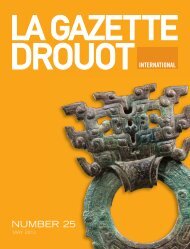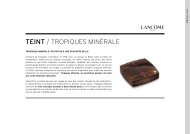Art Market Magazine - Visit zone-secure.net
Art Market Magazine - Visit zone-secure.net
Art Market Magazine - Visit zone-secure.net
You also want an ePaper? Increase the reach of your titles
YUMPU automatically turns print PDFs into web optimized ePapers that Google loves.
THE MAGAZINE DISCOVERY<br />
the Chinese art trade when the First World War<br />
erupted, C.T. Loo, who had also successfully set up<br />
shop in the United States, chose the gallery in Rue<br />
de Courcelles as his epicentre. Europe still enjoyed a<br />
glittering cultural aura, and Paris even more so. So<br />
this is where he received his clientele – to dazzle<br />
them as his rival Yamanaka had done with his Japanese<br />
temple in the heart of New York. Loo sank a<br />
fortune into this project: over FF8 million, according<br />
to Géraldine Lenain – the equivalent of €4.5 million<br />
today. Using a Louis-Philippe mansion as a base, the<br />
architect Fernand Bloch installed imaginatively<br />
reworked Chinese-style decoration, including<br />
curved canopies with varnished tiles, elaborate<br />
balustrades and a portico carved with tigers and<br />
dragons. C.T. Loo spared no expense. On the<br />
ground floor, he designed a "knights' room" with<br />
caisson ceilings and friezes inspired by Han dynasty<br />
reliefs. On the first floor, he decked out the salons<br />
with 18th century lacquer panels made from Shanxi<br />
screens. And on the top floor, he hung the Indian<br />
gallery with luxurious wood panelling from a 19th<br />
century residence in Pondicherry. All these interior<br />
decorations are now listed as Historic Monuments.<br />
This astounding Pagoda provided an exotic setting<br />
for the collections of C.T. Loo, whose remarkable<br />
ascension was finally halted by the Chinese revolution.<br />
The arrival of the Communists destroyed the<br />
business of this remarkable dealer, who thus lost a<br />
crucial asset: his <strong>net</strong>work. This fascinating emblem<br />
is what remains of his success. After Loo died in<br />
1957, the Pagoda remained in the hands of his<br />
family until 2011, when after being sold and admirably<br />
restored, it recovered its former glory. The<br />
gallery, managed by Jacqueline Von Hammerstein,<br />
now houses the celebrated dealer's archives and<br />
library, and more than ever represents a corner of<br />
Paris that is forever China.<br />
Stéphanie Perris-Delmas<br />
I<br />
<strong>Art</strong>s Infine Brancati,<br />
The Pagoda, 48 Rue de Courcelles, Paris<br />
Jacopo<br />
www.pagodaparis.com ©<br />
W<br />
92 GAZETTE DROUOT INTERNATIONAL I N° 23<br />
The panels from the red salon decorated in flowers<br />
and animals, made of Shanxi screens.
















